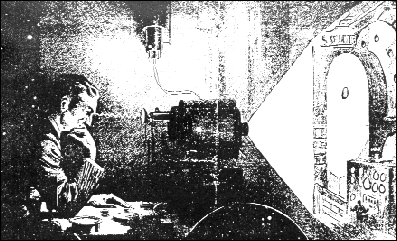alien productions
[Martin Breindl | Norbert Math | Andrea Sodomka | August Black]
[Martin Breindl | Norbert Math | Andrea Sodomka | August Black]
DER GEDANKENPROJEKTOR, Künstlerhaus Graz, Sept./Oct. 2007

Nikola Tesla and his thought-projector, news paper illustration, 1933
The idea for DER
GEDANKENPROJEKTOR comes from a - never realized -
invention of Nikola Tesla: a camera with which you can photograph thoughts.
In 1933, at the age of 78, Tesla said: "In 1893 [...] I became convinced that a definite image formed in thought, must by reflex action, produce a corresponding image on the retina, which might be read by a suitable apparatus. This brought me to my system of television which I announced at the time... My idea was to employ an artificial retina receiving and object of the image seen, an optic nerve and another retina at the place of reproduction...both being fashioned somewhat like a checkerboard, with the optic nerve being a part of the earth."
[Retinal Photography:]
The idea that a picture could be recorded from the human retina was not unusual in the second half of the 19th century. It was generally accepted that the last thing a dying person would see would be fixed on the retina for a short time. And, if done within a certain time-frame, the picture of a murderer could be found on the victims retina. (ex. In the case of Emma Jackson, murdered in 1863 in St. Giles in London. William H. Warner, a prominent British photographer suggested this to the assigned detective from Scotland Yard. The idea was discussed at length in this case for the first time in history. However, the idea itself was not new at the time.)

[Rhodopsin:]
Obviously, the human eye was seen as a kind of camera with its lens, iris, and retina, and was ascribed with the functionality of recording; an assumption to which more support was given through the discovery by Franz Boll in 1887 of Rhodopsin. Rhodopsin is a very light sensitive red dye in the rods of the retina. Through exposure to light, a chemical reaction splits the rhodopsin up into opsin and 11-Cis retinal, and through this becomes yellow and probably effects the image. Rhodopsin is to the eye what silver gelatine is to photo paper.
[Thoght Photography:]
A receiver is basically the same thing as a broadcaster. That is obviously what Nikola Tesla thought as he invented, so to say, a machine that, as a byproduct of television, continually projects thoughts inside people. At the other end of the scale, in the area of the paranormal and occult, a lot of "aura-photographers" tried with some success to record their thoughts onto photo paper without any kind of camera and just through concentration.Experiments started with Karl Ludwig Freiherr von Reichenbach in Berlin in 1861/62, the French Hyppolyte Baraduc, Lois Darget, and Jules-Bernard Luys at the turn of the 20th century, by the Russia Semyon Kirlian in the 1940's up to the "thoughtographs" of American Ted Serios in the 1960's.

We live in an age of surveillance, where thousands of cameras are pointed at us daily in order to detect "abnormal" or "suspicious" behavior and anticipate the evil intentions of individuals. While the necessary image recognition mechanisms and software are already available for face recognitions and so forth, it would be even more alluring to those in charge as well as their orderlies, to read and record people's thoughts. While our behavior becomes more and more regulated by the camera technology of Bentham's Panopticon, our thoughts are supposedly still free. But, the questions still stands, for how long?
[Fish-Eye:]
While a housewife was cleaning a large cat fish, she was surprised to discover an exact picture of a fisherman in the eye of the fish. It was a clear miniature of a completely equipped fisherman in rain gear just about to bring the fish on board.
[published 1869] in: Bill Jay, Cyanide &
Spirits. An-Inside-Out View of Early Photographs. Nazraeli Press;
quoted by: Luna Córnea, Número 10; México D.F.,
Centro de la Imagen, Sep/Dic 1996.